Taxation Law Assignment: Analyzing Income, FBT, and Capital Gains Tax
VerifiedAdded on 2023/06/11
|6
|1254
|306
Homework Assignment
AI Summary
This assignment solution provides a detailed analysis of various taxation law concepts. It addresses whether payments received by Hilary, a mountain climber, for her life story, manuscript sales, and photographs constitute income from personal exertion, concluding they do not due to the lack of intrinsic commercial value in the writing or photography skills. The solution then calculates the taxable value of a car fringe benefit using the statutory formula under FBTAA 1986, considering the car's cost, usage, and employee contributions. Further, it examines the tax implications of a son returning money to his parent, distinguishing between principal repayment (non-taxable) and interest payment (considered a gift and thus non-taxable). Finally, the assignment addresses capital gains tax implications on property sales, including scenarios with different CGT eras, sales to family members at reduced prices, and property ownership by a company, calculating taxable capital gains using appropriate methods like the discount and indexation methods.
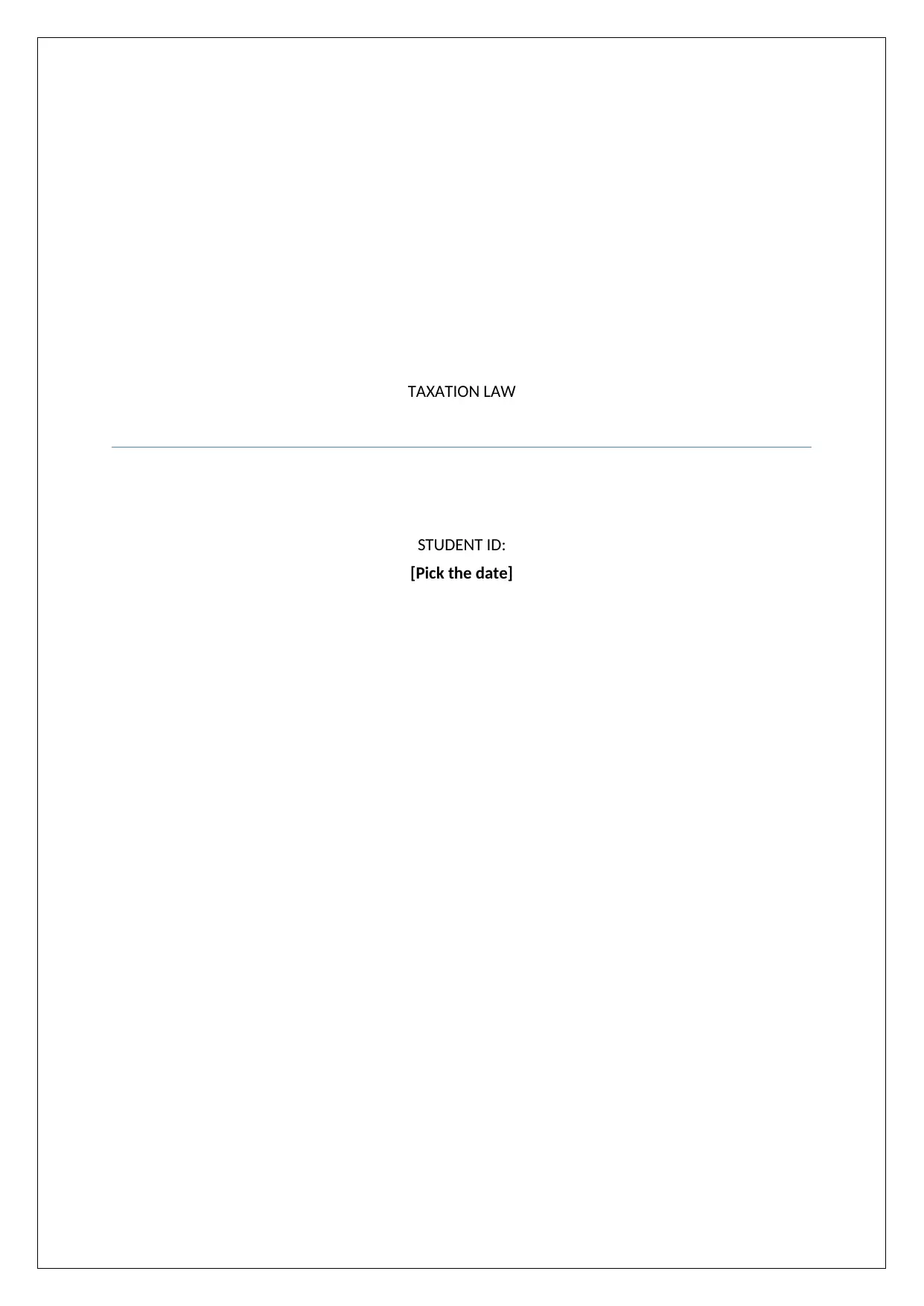
TAXATION LAW
STUDENT ID:
[Pick the date]
STUDENT ID:
[Pick the date]
Paraphrase This Document
Need a fresh take? Get an instant paraphrase of this document with our AI Paraphraser
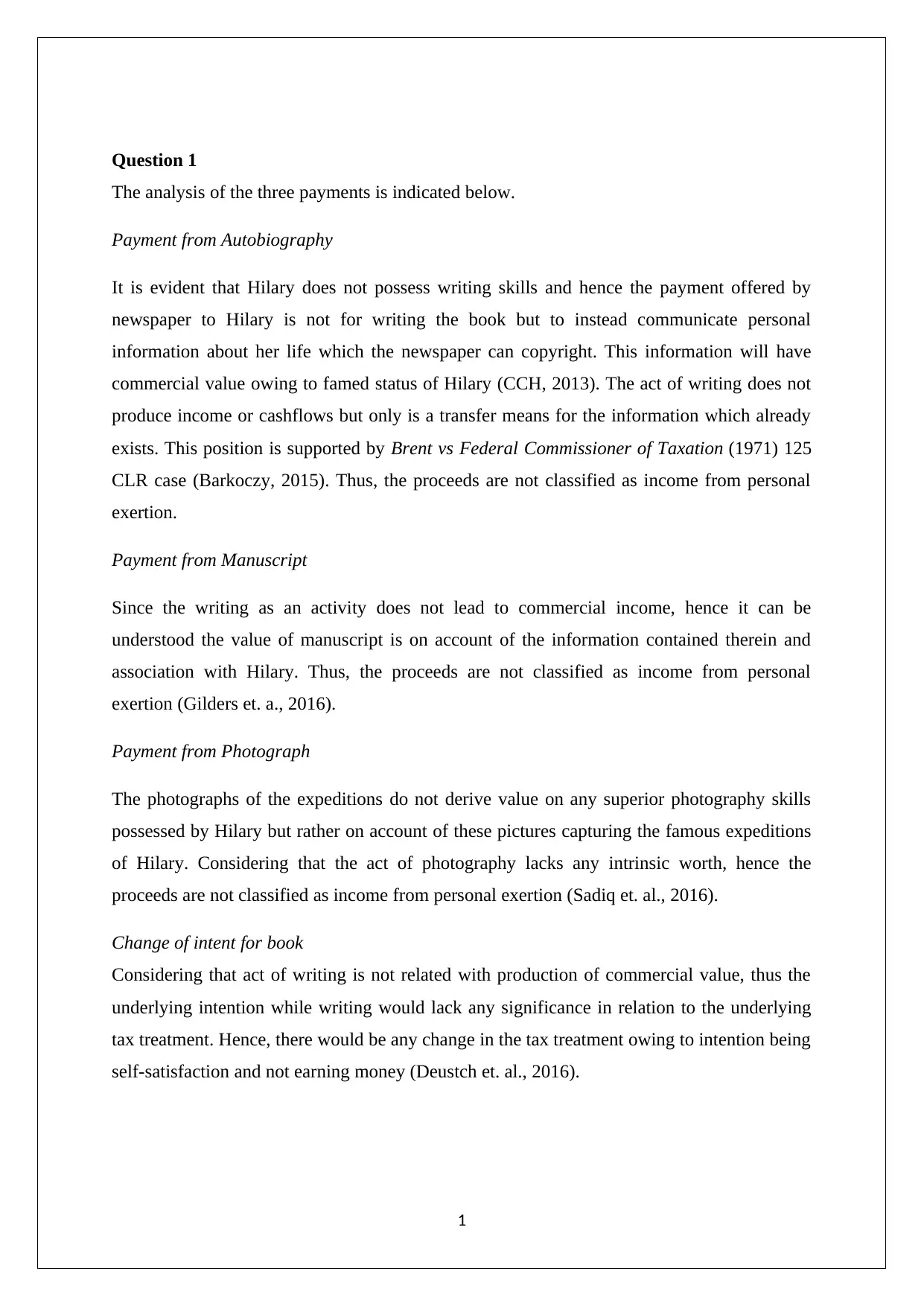
Question 1
The analysis of the three payments is indicated below.
Payment from Autobiography
It is evident that Hilary does not possess writing skills and hence the payment offered by
newspaper to Hilary is not for writing the book but to instead communicate personal
information about her life which the newspaper can copyright. This information will have
commercial value owing to famed status of Hilary (CCH, 2013). The act of writing does not
produce income or cashflows but only is a transfer means for the information which already
exists. This position is supported by Brent vs Federal Commissioner of Taxation (1971) 125
CLR case (Barkoczy, 2015). Thus, the proceeds are not classified as income from personal
exertion.
Payment from Manuscript
Since the writing as an activity does not lead to commercial income, hence it can be
understood the value of manuscript is on account of the information contained therein and
association with Hilary. Thus, the proceeds are not classified as income from personal
exertion (Gilders et. a., 2016).
Payment from Photograph
The photographs of the expeditions do not derive value on any superior photography skills
possessed by Hilary but rather on account of these pictures capturing the famous expeditions
of Hilary. Considering that the act of photography lacks any intrinsic worth, hence the
proceeds are not classified as income from personal exertion (Sadiq et. al., 2016).
Change of intent for book
Considering that act of writing is not related with production of commercial value, thus the
underlying intention while writing would lack any significance in relation to the underlying
tax treatment. Hence, there would be any change in the tax treatment owing to intention being
self-satisfaction and not earning money (Deustch et. al., 2016).
1
The analysis of the three payments is indicated below.
Payment from Autobiography
It is evident that Hilary does not possess writing skills and hence the payment offered by
newspaper to Hilary is not for writing the book but to instead communicate personal
information about her life which the newspaper can copyright. This information will have
commercial value owing to famed status of Hilary (CCH, 2013). The act of writing does not
produce income or cashflows but only is a transfer means for the information which already
exists. This position is supported by Brent vs Federal Commissioner of Taxation (1971) 125
CLR case (Barkoczy, 2015). Thus, the proceeds are not classified as income from personal
exertion.
Payment from Manuscript
Since the writing as an activity does not lead to commercial income, hence it can be
understood the value of manuscript is on account of the information contained therein and
association with Hilary. Thus, the proceeds are not classified as income from personal
exertion (Gilders et. a., 2016).
Payment from Photograph
The photographs of the expeditions do not derive value on any superior photography skills
possessed by Hilary but rather on account of these pictures capturing the famous expeditions
of Hilary. Considering that the act of photography lacks any intrinsic worth, hence the
proceeds are not classified as income from personal exertion (Sadiq et. al., 2016).
Change of intent for book
Considering that act of writing is not related with production of commercial value, thus the
underlying intention while writing would lack any significance in relation to the underlying
tax treatment. Hence, there would be any change in the tax treatment owing to intention being
self-satisfaction and not earning money (Deustch et. al., 2016).
1
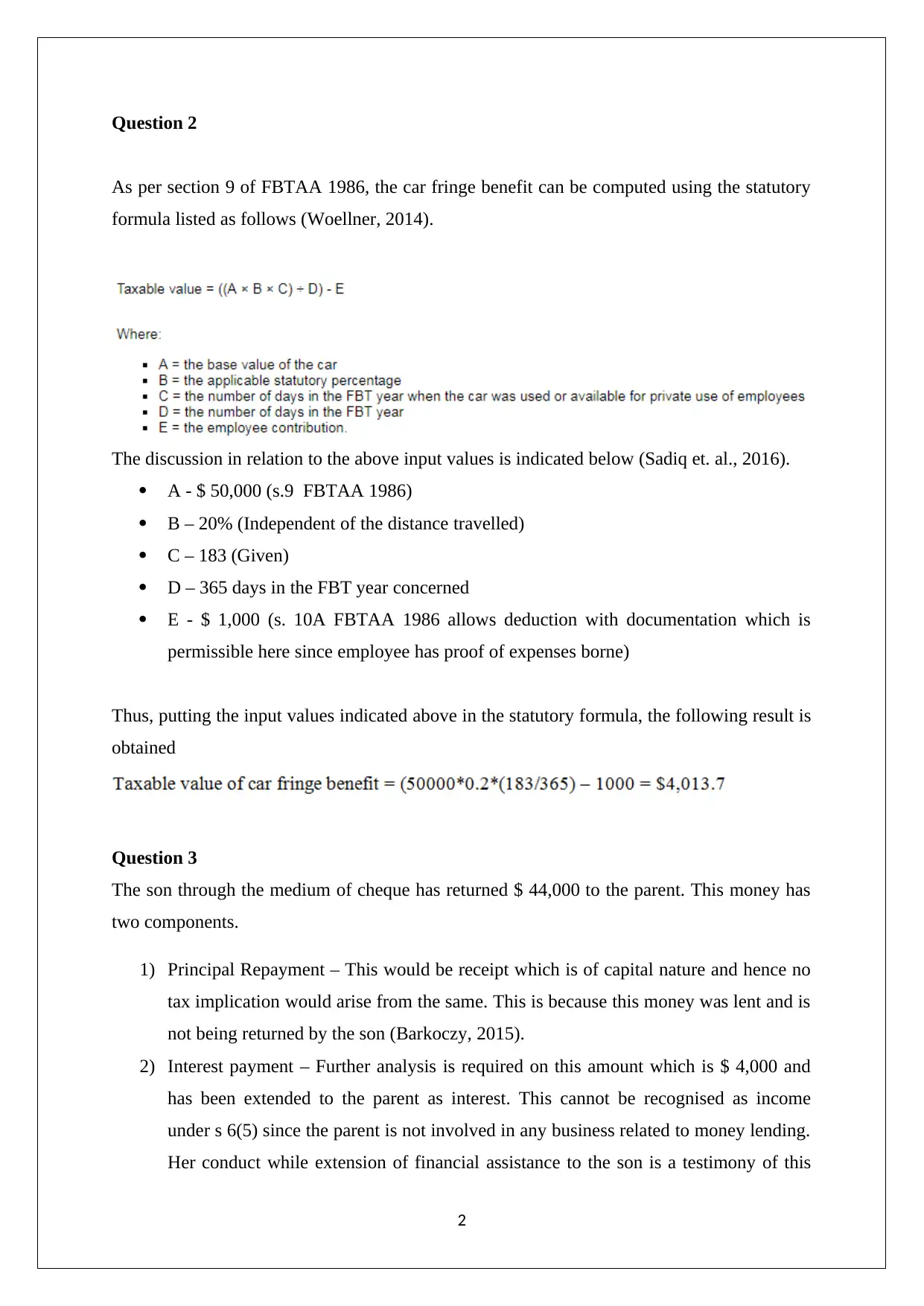
Question 2
As per section 9 of FBTAA 1986, the car fringe benefit can be computed using the statutory
formula listed as follows (Woellner, 2014).
The discussion in relation to the above input values is indicated below (Sadiq et. al., 2016).
A - $ 50,000 (s.9 FBTAA 1986)
B – 20% (Independent of the distance travelled)
C – 183 (Given)
D – 365 days in the FBT year concerned
E - $ 1,000 (s. 10A FBTAA 1986 allows deduction with documentation which is
permissible here since employee has proof of expenses borne)
Thus, putting the input values indicated above in the statutory formula, the following result is
obtained
Question 3
The son through the medium of cheque has returned $ 44,000 to the parent. This money has
two components.
1) Principal Repayment – This would be receipt which is of capital nature and hence no
tax implication would arise from the same. This is because this money was lent and is
not being returned by the son (Barkoczy, 2015).
2) Interest payment – Further analysis is required on this amount which is $ 4,000 and
has been extended to the parent as interest. This cannot be recognised as income
under s 6(5) since the parent is not involved in any business related to money lending.
Her conduct while extension of financial assistance to the son is a testimony of this
2
As per section 9 of FBTAA 1986, the car fringe benefit can be computed using the statutory
formula listed as follows (Woellner, 2014).
The discussion in relation to the above input values is indicated below (Sadiq et. al., 2016).
A - $ 50,000 (s.9 FBTAA 1986)
B – 20% (Independent of the distance travelled)
C – 183 (Given)
D – 365 days in the FBT year concerned
E - $ 1,000 (s. 10A FBTAA 1986 allows deduction with documentation which is
permissible here since employee has proof of expenses borne)
Thus, putting the input values indicated above in the statutory formula, the following result is
obtained
Question 3
The son through the medium of cheque has returned $ 44,000 to the parent. This money has
two components.
1) Principal Repayment – This would be receipt which is of capital nature and hence no
tax implication would arise from the same. This is because this money was lent and is
not being returned by the son (Barkoczy, 2015).
2) Interest payment – Further analysis is required on this amount which is $ 4,000 and
has been extended to the parent as interest. This cannot be recognised as income
under s 6(5) since the parent is not involved in any business related to money lending.
Her conduct while extension of financial assistance to the son is a testimony of this
2
⊘ This is a preview!⊘
Do you want full access?
Subscribe today to unlock all pages.

Trusted by 1+ million students worldwide
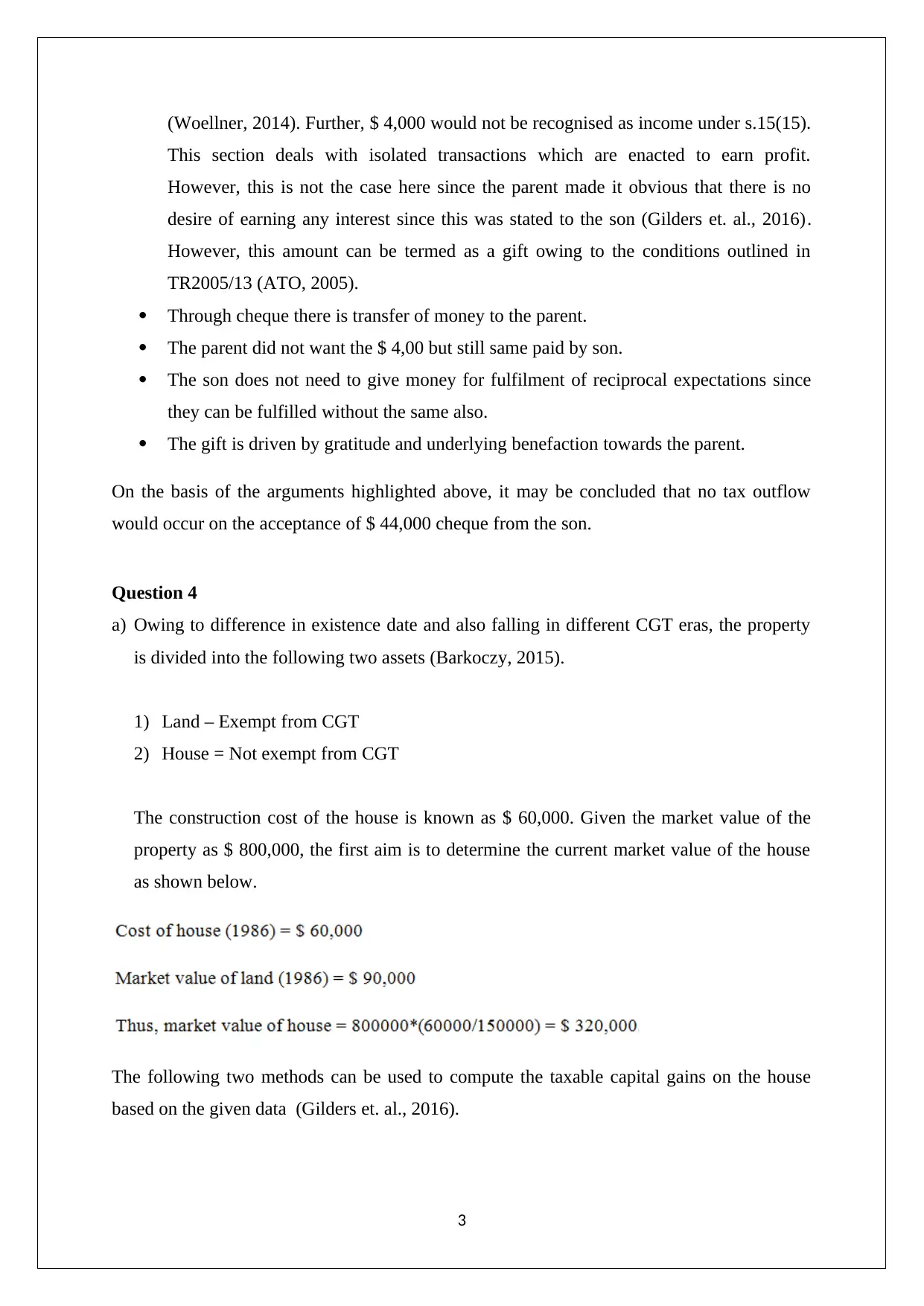
(Woellner, 2014). Further, $ 4,000 would not be recognised as income under s.15(15).
This section deals with isolated transactions which are enacted to earn profit.
However, this is not the case here since the parent made it obvious that there is no
desire of earning any interest since this was stated to the son (Gilders et. al., 2016).
However, this amount can be termed as a gift owing to the conditions outlined in
TR2005/13 (ATO, 2005).
Through cheque there is transfer of money to the parent.
The parent did not want the $ 4,00 but still same paid by son.
The son does not need to give money for fulfilment of reciprocal expectations since
they can be fulfilled without the same also.
The gift is driven by gratitude and underlying benefaction towards the parent.
On the basis of the arguments highlighted above, it may be concluded that no tax outflow
would occur on the acceptance of $ 44,000 cheque from the son.
Question 4
a) Owing to difference in existence date and also falling in different CGT eras, the property
is divided into the following two assets (Barkoczy, 2015).
1) Land – Exempt from CGT
2) House = Not exempt from CGT
The construction cost of the house is known as $ 60,000. Given the market value of the
property as $ 800,000, the first aim is to determine the current market value of the house
as shown below.
The following two methods can be used to compute the taxable capital gains on the house
based on the given data (Gilders et. al., 2016).
3
This section deals with isolated transactions which are enacted to earn profit.
However, this is not the case here since the parent made it obvious that there is no
desire of earning any interest since this was stated to the son (Gilders et. al., 2016).
However, this amount can be termed as a gift owing to the conditions outlined in
TR2005/13 (ATO, 2005).
Through cheque there is transfer of money to the parent.
The parent did not want the $ 4,00 but still same paid by son.
The son does not need to give money for fulfilment of reciprocal expectations since
they can be fulfilled without the same also.
The gift is driven by gratitude and underlying benefaction towards the parent.
On the basis of the arguments highlighted above, it may be concluded that no tax outflow
would occur on the acceptance of $ 44,000 cheque from the son.
Question 4
a) Owing to difference in existence date and also falling in different CGT eras, the property
is divided into the following two assets (Barkoczy, 2015).
1) Land – Exempt from CGT
2) House = Not exempt from CGT
The construction cost of the house is known as $ 60,000. Given the market value of the
property as $ 800,000, the first aim is to determine the current market value of the house
as shown below.
The following two methods can be used to compute the taxable capital gains on the house
based on the given data (Gilders et. al., 2016).
3
Paraphrase This Document
Need a fresh take? Get an instant paraphrase of this document with our AI Paraphraser
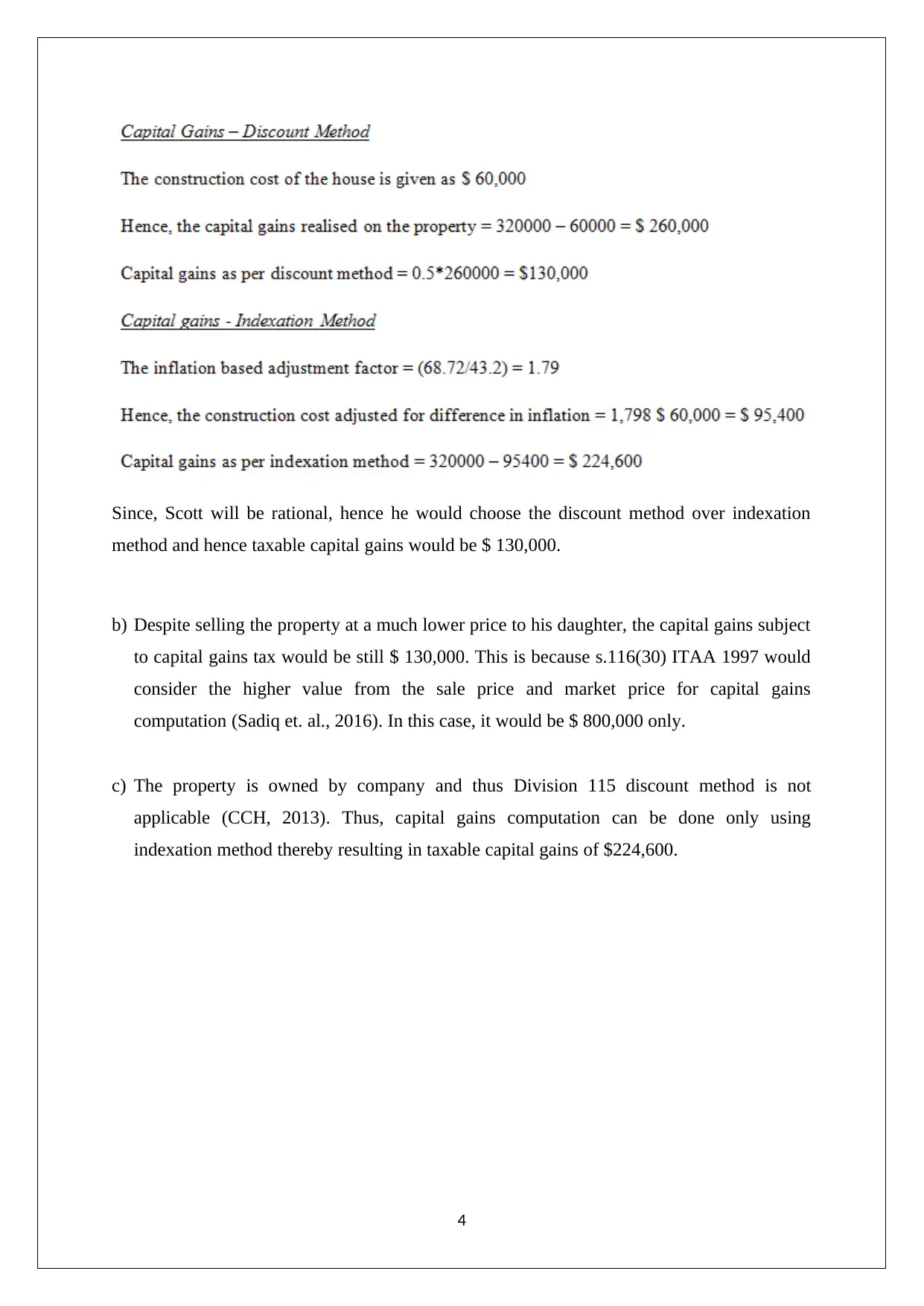
Since, Scott will be rational, hence he would choose the discount method over indexation
method and hence taxable capital gains would be $ 130,000.
b) Despite selling the property at a much lower price to his daughter, the capital gains subject
to capital gains tax would be still $ 130,000. This is because s.116(30) ITAA 1997 would
consider the higher value from the sale price and market price for capital gains
computation (Sadiq et. al., 2016). In this case, it would be $ 800,000 only.
c) The property is owned by company and thus Division 115 discount method is not
applicable (CCH, 2013). Thus, capital gains computation can be done only using
indexation method thereby resulting in taxable capital gains of $224,600.
4
method and hence taxable capital gains would be $ 130,000.
b) Despite selling the property at a much lower price to his daughter, the capital gains subject
to capital gains tax would be still $ 130,000. This is because s.116(30) ITAA 1997 would
consider the higher value from the sale price and market price for capital gains
computation (Sadiq et. al., 2016). In this case, it would be $ 800,000 only.
c) The property is owned by company and thus Division 115 discount method is not
applicable (CCH, 2013). Thus, capital gains computation can be done only using
indexation method thereby resulting in taxable capital gains of $224,600.
4
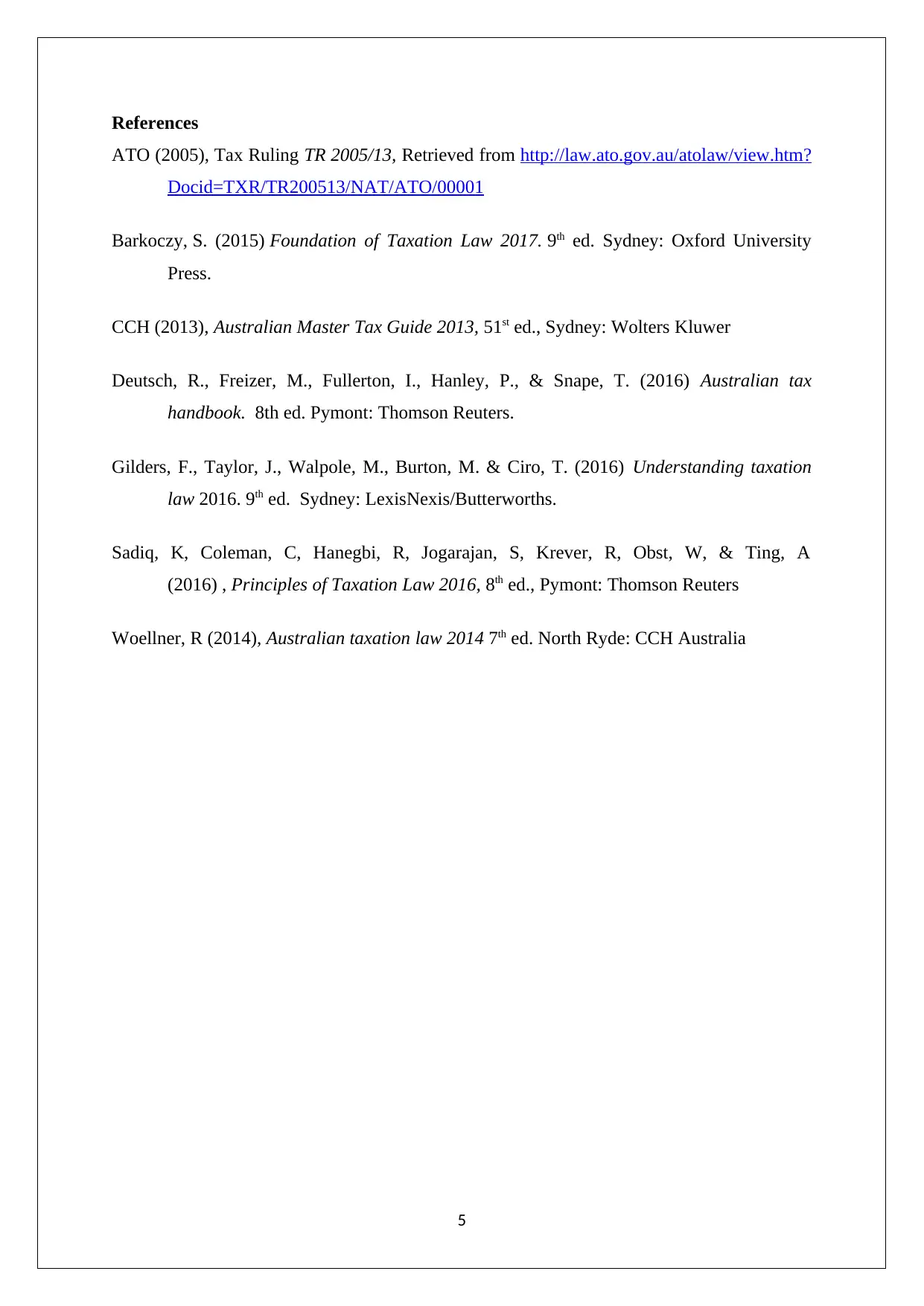
References
ATO (2005), Tax Ruling TR 2005/13, Retrieved from http://law.ato.gov.au/atolaw/view.htm?
Docid=TXR/TR200513/NAT/ATO/00001
Barkoczy, S. (2015) Foundation of Taxation Law 2017. 9th ed. Sydney: Oxford University
Press.
CCH (2013), Australian Master Tax Guide 2013, 51st ed., Sydney: Wolters Kluwer
Deutsch, R., Freizer, M., Fullerton, I., Hanley, P., & Snape, T. (2016) Australian tax
handbook. 8th ed. Pymont: Thomson Reuters.
Gilders, F., Taylor, J., Walpole, M., Burton, M. & Ciro, T. (2016) Understanding taxation
law 2016. 9th ed. Sydney: LexisNexis/Butterworths.
Sadiq, K, Coleman, C, Hanegbi, R, Jogarajan, S, Krever, R, Obst, W, & Ting, A
(2016) , Principles of Taxation Law 2016, 8th ed., Pymont: Thomson Reuters
Woellner, R (2014), Australian taxation law 2014 7th ed. North Ryde: CCH Australia
5
ATO (2005), Tax Ruling TR 2005/13, Retrieved from http://law.ato.gov.au/atolaw/view.htm?
Docid=TXR/TR200513/NAT/ATO/00001
Barkoczy, S. (2015) Foundation of Taxation Law 2017. 9th ed. Sydney: Oxford University
Press.
CCH (2013), Australian Master Tax Guide 2013, 51st ed., Sydney: Wolters Kluwer
Deutsch, R., Freizer, M., Fullerton, I., Hanley, P., & Snape, T. (2016) Australian tax
handbook. 8th ed. Pymont: Thomson Reuters.
Gilders, F., Taylor, J., Walpole, M., Burton, M. & Ciro, T. (2016) Understanding taxation
law 2016. 9th ed. Sydney: LexisNexis/Butterworths.
Sadiq, K, Coleman, C, Hanegbi, R, Jogarajan, S, Krever, R, Obst, W, & Ting, A
(2016) , Principles of Taxation Law 2016, 8th ed., Pymont: Thomson Reuters
Woellner, R (2014), Australian taxation law 2014 7th ed. North Ryde: CCH Australia
5
⊘ This is a preview!⊘
Do you want full access?
Subscribe today to unlock all pages.

Trusted by 1+ million students worldwide
1 out of 6
Related Documents
Your All-in-One AI-Powered Toolkit for Academic Success.
+13062052269
info@desklib.com
Available 24*7 on WhatsApp / Email
![[object Object]](/_next/static/media/star-bottom.7253800d.svg)
Unlock your academic potential
Copyright © 2020–2025 A2Z Services. All Rights Reserved. Developed and managed by ZUCOL.




